LSM9DS1TR Gyroscope Magnetometer 9 Axis Sensor I²C SPI Output: Datasheet, Features, and Pinout
IMU ACCEL/GYRO/MAG I2C/SPI 24LGA
LSM9DS1TR is a motion sensor. It has an I2C serial bus interface with standard and fast modes (100 and 400 kHz), as well as an SPI serial standard interface. This article is going to talk about more detailed information about LSM9DS1TR.
- Overview of LSM9DS1TR
- LSM9DS1TR Features
- LSM9DS1TR Pinout
- LSM9DS1TR Block Diagram
- Parts with Similar Specs
- Specifications
- LSM9DS1 Electrical Connections
- LSM9DS1TR Electrical characteristics
- LSM9DS1TR Absolute maximum ratings
- LSM9DS1TR Recommended power-up sequence
- LSM9DS1TR Operating modes
- LSM9DS1TR Applications
- LSM9DS1TR Package information
- LSM9DS1TR Manufacturer
- Datasheet PDF
- Popularity by Region
Overview of LSM9DS1TR
A 3D digital linear acceleration sensor, a 3D digital angular rate sensor, and a 3D digital magnetic sensor are all included in the LSM9DS1. The LSM9DS1 has an I2C serial bus interface with standard and fast modes (100 and 400 kHz), as well as an SPI serial standard interface. The LSM9DS1 comes in a plastic land grid array package (LGA) and is guaranteed to work in temperatures ranging from -40 to +85 degrees Celsius.
LSM9DS1TR Features
• 3 acceleration channels, 3 angular rate channels, 3 magnetic field channels
• ±2/±4/±8/±16 g linear acceleration full scale
• ±4/±8/±12/±16 gauss magnetic full scale
• ±245/±500/±2000 DPS angular rate full scale
• 16-bit data output
• SPI / I2C serial interfaces
• Analog supply voltage 1.9 V to 3.6 V
• “Always-on” eco power mode down to 1.9 mA
• Programmable interrupt generators
• Embedded temperature sensor
• Embedded FIFO
• Position and motion detection functions
• Click/double-click recognition
• Intelligent power saving for handheld devices
• ECOPACK®, RoHS, and “Green” compliant
LSM9DS1TR Pinout
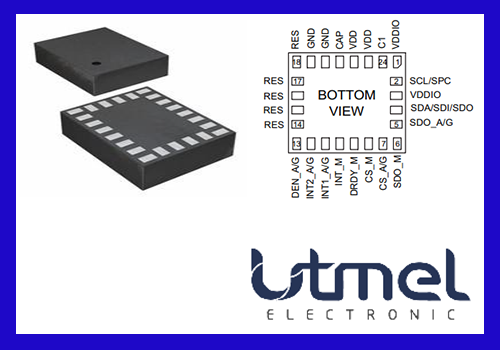
LSM9DS1TR Pinout
LSM9DS1TR Block Diagram
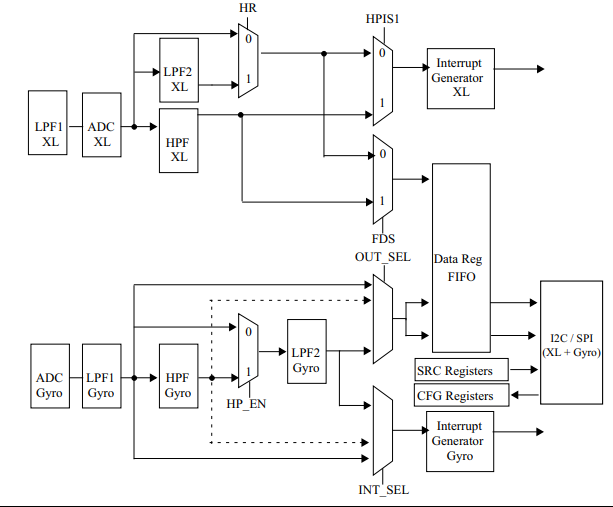
Accelerometer and gyroscope digital block diagram
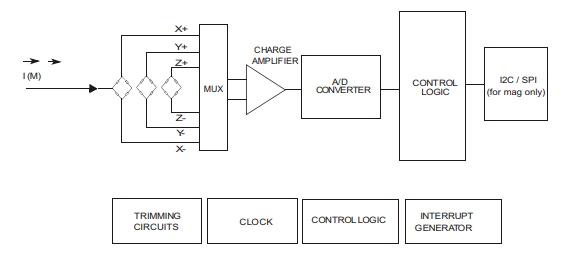
Magnetometer block diagram
Parts with Similar Specs
- ImagePart NumberManufacturerPackage / CaseNumber of PinsMin Supply VoltageSupply VoltageMax Supply VoltageOperating TemperatureOutput TypeMounting TypeView Compare
LSM9DS1TR
24-TFLGA Module
24
1.9 V
2.2 V
3.6 V
-40°C ~ 85°C (TA)
I2C, SPI
Surface Mount
24-TFLGA Module
24
2.4 V
3 V
3.6 V
-40°C ~ 85°C (TA)
I2C, SPI
Surface Mount
24-TFQFN Module Exposed Pad
24
-
-
-
-40°C ~ 85°C (TA)
I2C, SPI
Surface Mount
Specifications
- TypeParameter
- Lifecycle Status
Lifecycle Status refers to the current stage of an electronic component in its product life cycle, indicating whether it is active, obsolete, or transitioning between these states. An active status means the component is in production and available for purchase. An obsolete status indicates that the component is no longer being manufactured or supported, and manufacturers typically provide a limited time frame for support. Understanding the lifecycle status is crucial for design engineers to ensure continuity and reliability in their projects.
ACTIVE (Last Updated: 7 months ago) - Factory Lead Time16 Weeks
- Mounting Type
The "Mounting Type" in electronic components refers to the method used to attach or connect a component to a circuit board or other substrate, such as through-hole, surface-mount, or panel mount.
Surface Mount - Package / Case
refers to the protective housing that encases an electronic component, providing mechanical support, electrical connections, and thermal management.
24-TFLGA Module - Surface Mount
having leads that are designed to be soldered on the side of a circuit board that the body of the component is mounted on.
YES - Number of Pins24
- Operating Temperature
The operating temperature is the range of ambient temperature within which a power supply, or any other electrical equipment, operate in. This ranges from a minimum operating temperature, to a peak or maximum operating temperature, outside which, the power supply may fail.
-40°C~85°C TA - Packaging
Semiconductor package is a carrier / shell used to contain and cover one or more semiconductor components or integrated circuits. The material of the shell can be metal, plastic, glass or ceramic.
Cut Tape (CT) - Part Status
Parts can have many statuses as they progress through the configuration, analysis, review, and approval stages.
Active - Moisture Sensitivity Level (MSL)
Moisture Sensitivity Level (MSL) is a standardized rating that indicates the susceptibility of electronic components, particularly semiconductors, to moisture-induced damage during storage and the soldering process, defining the allowable exposure time to ambient conditions before they require special handling or baking to prevent failures
3 (168 Hours) - Number of Terminations24
- ECCN Code
An ECCN (Export Control Classification Number) is an alphanumeric code used by the U.S. Bureau of Industry and Security to identify and categorize electronic components and other dual-use items that may require an export license based on their technical characteristics and potential for military use.
EAR99 - HTS Code
HTS (Harmonized Tariff Schedule) codes are product classification codes between 8-1 digits. The first six digits are an HS code, and the countries of import assign the subsequent digits to provide additional classification. U.S. HTS codes are 1 digits and are administered by the U.S. International Trade Commission.
8542.39.00.01 - Terminal Position
In electronic components, the term "Terminal Position" refers to the physical location of the connection points on the component where external electrical connections can be made. These connection points, known as terminals, are typically used to attach wires, leads, or other components to the main body of the electronic component. The terminal position is important for ensuring proper connectivity and functionality of the component within a circuit. It is often specified in technical datasheets or component specifications to help designers and engineers understand how to properly integrate the component into their circuit designs.
BOTTOM - Terminal Form
Occurring at or forming the end of a series, succession, or the like; closing; concluding.
BUTT - Peak Reflow Temperature (Cel)
Peak Reflow Temperature (Cel) is a parameter that specifies the maximum temperature at which an electronic component can be exposed during the reflow soldering process. Reflow soldering is a common method used to attach electronic components to a circuit board. The Peak Reflow Temperature is crucial because it ensures that the component is not damaged or degraded during the soldering process. Exceeding the specified Peak Reflow Temperature can lead to issues such as component failure, reduced performance, or even permanent damage to the component. It is important for manufacturers and assemblers to adhere to the recommended Peak Reflow Temperature to ensure the reliability and functionality of the electronic components.
NOT SPECIFIED - Number of Functions1
- Supply Voltage
Supply voltage refers to the electrical potential difference provided to an electronic component or circuit. It is crucial for the proper operation of devices, as it powers their functions and determines performance characteristics. The supply voltage must be within specified limits to ensure reliability and prevent damage to components. Different electronic devices have specific supply voltage requirements, which can vary widely depending on their design and intended application.
2.2V - Terminal Pitch
The center distance from one pole to the next.
0.43mm - Time@Peak Reflow Temperature-Max (s)
Time@Peak Reflow Temperature-Max (s) refers to the maximum duration that an electronic component can be exposed to the peak reflow temperature during the soldering process, which is crucial for ensuring reliable solder joint formation without damaging the component.
NOT SPECIFIED - Base Part Number
The "Base Part Number" (BPN) in electronic components serves a similar purpose to the "Base Product Number." It refers to the primary identifier for a component that captures the essential characteristics shared by a group of similar components. The BPN provides a fundamental way to reference a family or series of components without specifying all the variations and specific details.
LSM9D - Output Type
The "Output Type" parameter in electronic components refers to the type of signal or data that is produced by the component as an output. This parameter specifies the nature of the output signal, such as analog or digital, and can also include details about the voltage levels, current levels, frequency, and other characteristics of the output signal. Understanding the output type of a component is crucial for ensuring compatibility with other components in a circuit or system, as well as for determining how the output signal can be utilized or processed further. In summary, the output type parameter provides essential information about the nature of the signal that is generated by the electronic component as its output.
I2C, SPI - Max Supply Voltage
In general, the absolute maximum common-mode voltage is VEE-0.3V and VCC+0.3V, but for products without a protection element at the VCC side, voltages up to the absolute maximum rated supply voltage (i.e. VEE+36V) can be supplied, regardless of supply voltage.
3.6V - Min Supply Voltage
The minimum supply voltage (V min ) is explored for sequential logic circuits by statistically simulating the impact of within-die process variations and gate-dielectric soft breakdown on data retention and hold time.
1.9V - Analog IC - Other Type
Analog IC - Other Type is a parameter used to categorize electronic components that are integrated circuits (ICs) designed for analog signal processing but do not fall into more specific subcategories such as amplifiers, comparators, or voltage regulators. These ICs may include specialized analog functions such as analog-to-digital converters (ADCs), digital-to-analog converters (DACs), voltage references, or signal conditioning circuits. They are typically used in various applications where precise analog signal processing is required, such as in audio equipment, instrumentation, communication systems, and industrial control systems. Manufacturers provide detailed specifications for these components to help engineers select the most suitable IC for their specific design requirements.
ANALOG CIRCUIT - Sensor Type
In electronic components, the parameter "Sensor Type" refers to the specific type of sensor technology used in a particular component to detect and measure physical phenomena such as light, temperature, pressure, motion, or proximity. Different sensor types utilize various principles and mechanisms to convert the detected input into an electrical signal that can be processed by the electronic component. Common sensor types include photodiodes, thermistors, accelerometers, and proximity sensors, each designed for specific applications and environments. Understanding the sensor type is crucial for selecting the right component for a given task and ensuring accurate and reliable sensing capabilities in electronic systems.
Accelerometer, Gyroscope, Magnetometer, Temperature, 9 Axis - Length3.5mm
- Height Seated (Max)
Height Seated (Max) is a parameter in electronic components that refers to the maximum allowable height of the component when it is properly seated or installed on a circuit board or within an enclosure. This specification is crucial for ensuring proper fit and alignment within the overall system design. Exceeding the maximum seated height can lead to mechanical interference, electrical shorts, or other issues that may impact the performance and reliability of the electronic device. Manufacturers provide this information to help designers and engineers select components that will fit within the designated space and function correctly in the intended application.
1.027mm - Width3mm
- REACH SVHC
The parameter "REACH SVHC" in electronic components refers to the compliance with the Registration, Evaluation, Authorization, and Restriction of Chemicals (REACH) regulation regarding Substances of Very High Concern (SVHC). SVHCs are substances that may have serious effects on human health or the environment, and their use is regulated under REACH to ensure their safe handling and minimize their impact.Manufacturers of electronic components need to declare if their products contain any SVHCs above a certain threshold concentration and provide information on the safe use of these substances. This information allows customers to make informed decisions about the potential risks associated with using the components and take appropriate measures to mitigate any hazards.Ensuring compliance with REACH SVHC requirements is essential for electronics manufacturers to meet regulatory standards, protect human health and the environment, and maintain transparency in their supply chain. It also demonstrates a commitment to sustainability and responsible manufacturing practices in the electronics industry.
No SVHC - RoHS Status
RoHS means “Restriction of Certain Hazardous Substances” in the “Hazardous Substances Directive” in electrical and electronic equipment.
ROHS3 Compliant - Lead Free
Lead Free is a term used to describe electronic components that do not contain lead as part of their composition. Lead is a toxic material that can have harmful effects on human health and the environment, so the electronics industry has been moving towards lead-free components to reduce these risks. Lead-free components are typically made using alternative materials such as silver, copper, and tin. Manufacturers must comply with regulations such as the Restriction of Hazardous Substances (RoHS) directive to ensure that their products are lead-free and environmentally friendly.
Lead Free
LSM9DS1 Electrical Connections
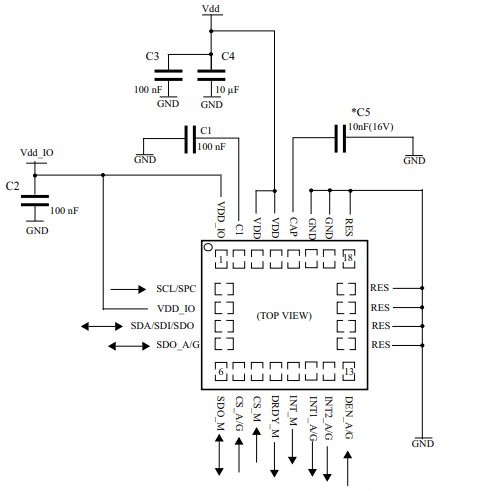
LSM9DS1 Electrical Connections
LSM9DS1TR Electrical characteristics
| Symbol | Parameter | Test conditions | Min. | Typ. (1) | Max. | Unit |
| Vdd | Supply voltage | 1.9 | 3.6 | V | ||
| Vdd_IO | Module power supply for I/O | 1.71 | Vdd+0.1 | |||
| Idd_XM | Current consumption of the accelerometer and magnetic sensor in normal mode (2 | 600 | µA | |||
| Idd_G | Gyroscope current consumption in normal mode(3) | 4 | mA | |||
| Top | Operating temperature range | -40 | 85 | °C | ||
| Trise | Time for power supply rising(4) | 0.01 | 100 | ms | ||
| Twait | The time delay between Vdd_IO and Vdd(4) | 0 | 10 | ms |
LSM9DS1TR Absolute maximum ratings
| Symbol | Ratings | Maximum value | Unit |
| Vdd | Supply voltage | -0.3 to 4.8 | V |
| Vdd_IO | I/O pins supply voltage | -0.3 to 4.8 | V |
| Vin | Input voltage on any control pin (including CS_A/G, CS_M, SCL/SPC, SDA/SDI/SDO, SDO_A/G, SDO_M) | 0.3 to Vdd_IO +0.3 | V |
| AUNP | Acceleration (any axis) | 3,000 for 0.5 ms | g |
| 10,000 for 0.1 ms | g | ||
| MEF | Maximum exposed field | 1000 | gauss |
| ESD | Electrostatic discharge protection (HBM) | 2 | kV |
| TSTG | Storage temperature range | -40 to +125 | °C |
LSM9DS1TR Recommended power-up sequence
For the power-up sequence please refer to the following figure, where:
• Triose is the time for the power supply to rise from 10% to 90% of its final value
• Twait is the delay between the end of the Vdd_IO ramp (90% of its final value) and the start of the Vdd ramp
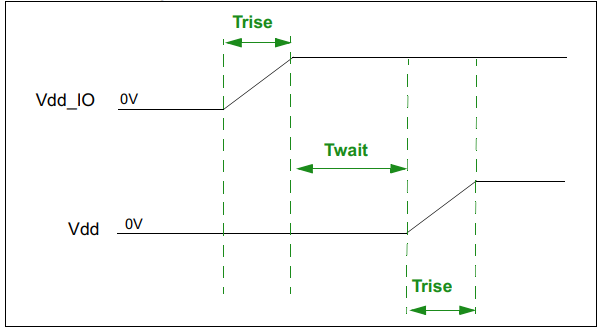
LSM9DS1TR Operating modes
The LSM9DS1 has two operating modes for the accelerometer and gyroscope: only the accelerometer is active and the gyroscope is powered off, or both accelerometer and gyroscope sensors are active at the same ODR.
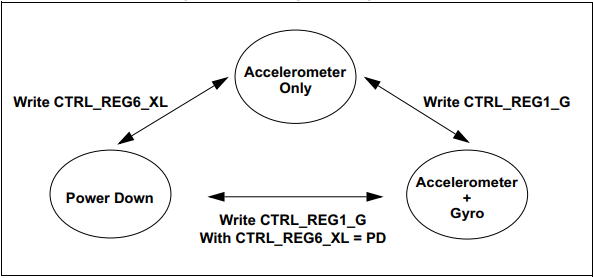
LSM9DS1TR Applications
• Indoor navigation
• Smart user interfaces
• Advanced gesture recognition
• Gaming and virtual reality input devices
• Display/map orientation and browsing
LSM9DS1TR Package information

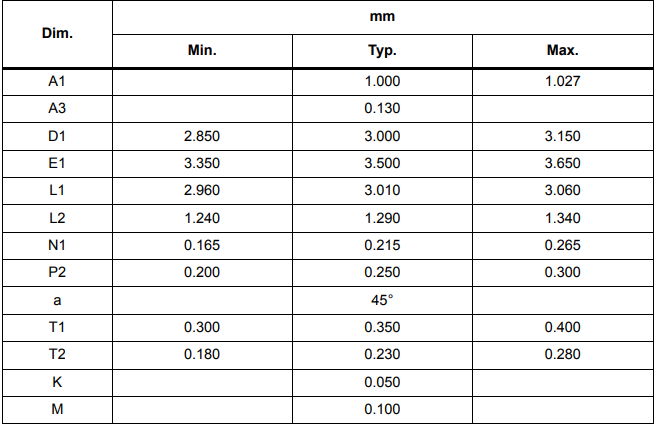
LSM9DS1TR Manufacturer
STMicroelectronics is a leading global independent semiconductor firm that develops and delivers semiconductor solutions for a wide range of microelectronics applications. The Company is at the forefront of System-on-Chip (SoC) technology, and its products play a major role in supporting today's convergence trends, thanks to an unparalleled mix of silicon and system expertise, manufacturing capabilities, and Intellectual Property (IP) portfolio, and strategic partners.
Datasheet PDF
- Datasheets :
Popularity by Region
What’s the operating temperature of LSM9DS1TR?
-40°C~85°C TA.
What’s the Supply Voltage of LSM9DS1TR?
2.2V.
How many pins of LSM9DS1TR?
24 pins.
What’s the packaging way of LSM9DS1TR?
The packaging way of LSM9DS1TR is Cut Tape (CT).
What’s the Max Supply Voltage of LSM9DS1TR?
3.6V.
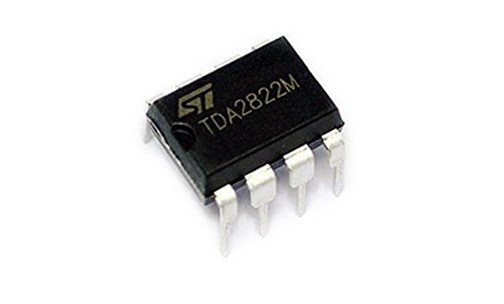 How To Make Simple Mini Stereo Audio Amplifier Circuit- TDA2822
How To Make Simple Mini Stereo Audio Amplifier Circuit- TDA282221 April 20251401
 Top Tips for Getting Started with EP2C5T144C8N FPGA Boards
Top Tips for Getting Started with EP2C5T144C8N FPGA Boards23 July 2025121
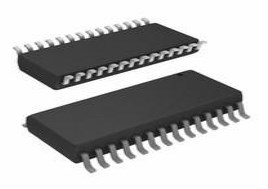 AT28BV256 EEPROMs: Pinout, Equivalent and Datasheet
AT28BV256 EEPROMs: Pinout, Equivalent and Datasheet20 December 2021669
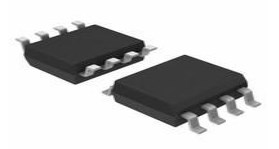 TL431A Integrated Circuit: Pinout, Equivalent and Datasheet
TL431A Integrated Circuit: Pinout, Equivalent and Datasheet12 November 20216122
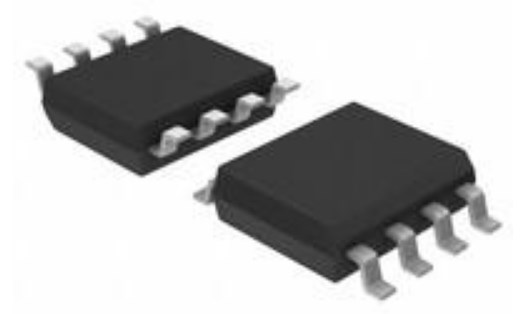 LM234 Current Source: Pinout, 3D Model and Datasheet
LM234 Current Source: Pinout, 3D Model and Datasheet29 October 20211999
![2CR5 Lithium battery[FAQ+Video]: Equivalents, Datasheet, and 2CR5 vs CR123A](https://res.utmel.com/Images/Article/d457194e-da35-4dca-b816-3e43f317da63.jpg) 2CR5 Lithium battery[FAQ+Video]: Equivalents, Datasheet, and 2CR5 vs CR123A
2CR5 Lithium battery[FAQ+Video]: Equivalents, Datasheet, and 2CR5 vs CR123A20 April 20227865
![LA4440 Power Amplifier: 6W 2-Channel Amplifier, Pinout and Circuit Diagram [Video]](https://res.utmel.com/Images/Article/1c557673-72fd-4beb-b307-0680a3165ac9.jpg) LA4440 Power Amplifier: 6W 2-Channel Amplifier, Pinout and Circuit Diagram [Video]
LA4440 Power Amplifier: 6W 2-Channel Amplifier, Pinout and Circuit Diagram [Video]08 December 202123800
 CD4051BM Analog Switch: Pinout, CAD Model and Specification
CD4051BM Analog Switch: Pinout, CAD Model and Specification14 August 20242976
 Global Semiconductor Market Share Continues to Grow
Global Semiconductor Market Share Continues to Grow27 October 2023548
 What is Network Topology?
What is Network Topology?23 December 20213499
 Detailed Analysis of Analog IC
Detailed Analysis of Analog IC22 November 20213025
 Millimeter Wave Radar: Advantages, Types, and Applications
Millimeter Wave Radar: Advantages, Types, and Applications18 October 202118542
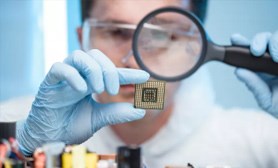 Long Life Small Volume Detector Switch for Intelligent Applications
Long Life Small Volume Detector Switch for Intelligent Applications16 March 20223019
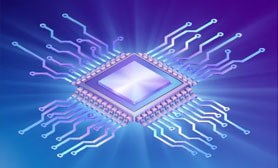 What is First In First Out (FIFO)?
What is First In First Out (FIFO)?30 November 20212793
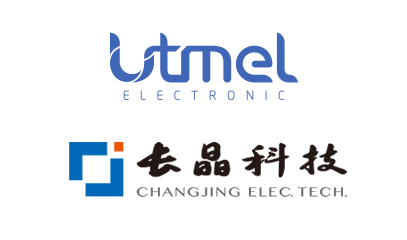 JSCJ Authorized Distributor | UTMEL Electronics
JSCJ Authorized Distributor | UTMEL Electronics21 November 20232343
 Basic Introduction to System on a Chip
Basic Introduction to System on a Chip02 December 20203527
STMicroelectronics
In Stock: 56000
United States
China
Canada
Japan
Russia
Germany
United Kingdom
Singapore
Italy
Hong Kong(China)
Taiwan(China)
France
Korea
Mexico
Netherlands
Malaysia
Austria
Spain
Switzerland
Poland
Thailand
Vietnam
India
United Arab Emirates
Afghanistan
Åland Islands
Albania
Algeria
American Samoa
Andorra
Angola
Anguilla
Antigua & Barbuda
Argentina
Armenia
Aruba
Australia
Azerbaijan
Bahamas
Bahrain
Bangladesh
Barbados
Belarus
Belgium
Belize
Benin
Bermuda
Bhutan
Bolivia
Bonaire, Sint Eustatius and Saba
Bosnia & Herzegovina
Botswana
Brazil
British Indian Ocean Territory
British Virgin Islands
Brunei
Bulgaria
Burkina Faso
Burundi
Cabo Verde
Cambodia
Cameroon
Cayman Islands
Central African Republic
Chad
Chile
Christmas Island
Cocos (Keeling) Islands
Colombia
Comoros
Congo
Congo (DRC)
Cook Islands
Costa Rica
Côte d’Ivoire
Croatia
Cuba
Curaçao
Cyprus
Czechia
Denmark
Djibouti
Dominica
Dominican Republic
Ecuador
Egypt
El Salvador
Equatorial Guinea
Eritrea
Estonia
Eswatini
Ethiopia
Falkland Islands
Faroe Islands
Fiji
Finland
French Guiana
French Polynesia
Gabon
Gambia
Georgia
Ghana
Gibraltar
Greece
Greenland
Grenada
Guadeloupe
Guam
Guatemala
Guernsey
Guinea
Guinea-Bissau
Guyana
Haiti
Honduras
Hungary
Iceland
Indonesia
Iran
Iraq
Ireland
Isle of Man
Israel
Jamaica
Jersey
Jordan
Kazakhstan
Kenya
Kiribati
Kosovo
Kuwait
Kyrgyzstan
Laos
Latvia
Lebanon
Lesotho
Liberia
Libya
Liechtenstein
Lithuania
Luxembourg
Macao(China)
Madagascar
Malawi
Maldives
Mali
Malta
Marshall Islands
Martinique
Mauritania
Mauritius
Mayotte
Micronesia
Moldova
Monaco
Mongolia
Montenegro
Montserrat
Morocco
Mozambique
Myanmar
Namibia
Nauru
Nepal
New Caledonia
New Zealand
Nicaragua
Niger
Nigeria
Niue
Norfolk Island
North Korea
North Macedonia
Northern Mariana Islands
Norway
Oman
Pakistan
Palau
Palestinian Authority
Panama
Papua New Guinea
Paraguay
Peru
Philippines
Pitcairn Islands
Portugal
Puerto Rico
Qatar
Réunion
Romania
Rwanda
Samoa
San Marino
São Tomé & Príncipe
Saudi Arabia
Senegal
Serbia
Seychelles
Sierra Leone
Sint Maarten
Slovakia
Slovenia
Solomon Islands
Somalia
South Africa
South Sudan
Sri Lanka
St Helena, Ascension, Tristan da Cunha
St. Barthélemy
St. Kitts & Nevis
St. Lucia
St. Martin
St. Pierre & Miquelon
St. Vincent & Grenadines
Sudan
Suriname
Svalbard & Jan Mayen
Sweden
Syria
Tajikistan
Tanzania
Timor-Leste
Togo
Tokelau
Tonga
Trinidad & Tobago
Tunisia
Turkey
Turkmenistan
Turks & Caicos Islands
Tuvalu
U.S. Outlying Islands
U.S. Virgin Islands
Uganda
Ukraine
Uruguay
Uzbekistan
Vanuatu
Vatican City
Venezuela
Wallis & Futuna
Yemen
Zambia
Zimbabwe

















